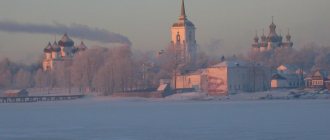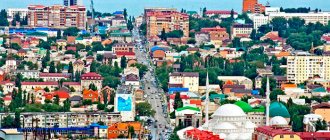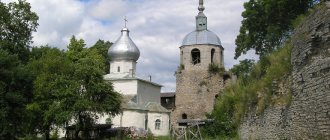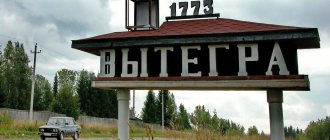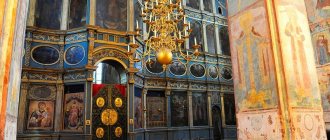Beloozero (Belozersk) is one of the oldest settlements in Russia
.
The official founding date of the city is considered to be 862
, when it was first mentioned in the “Tale of Bygone Years” in the context of the calling of the Varangians-Rus. Many people have repeatedly written about what kind of Varangians they were, and it seems that today the myth about certain foreign Normans has completely exhausted itself. There are no traces of “Vikings” either in the Russian language or in the archaeological finds of the most ancient Russian cities. “Their” Slavic princes were invited from the shores of the Baltic (Polabian Rus') - the same language, culture and origin as us, whose very names are read in Russian (“Rurik”, “Rorik”, “rarog” - in Slavic languages means falcon , which was the symbol of the Rurikovich family later). By the way, one of the centers of this Polabian Rus' was the temple city of Arkona (Rügen Island, Germany), famous precisely for its military traditions - it is not surprising that it was these Western Slavs who were turned to so that they would bring the corresponding knowledge to Eastern Rus'.
I.Glazunov. Gostomysl's grandchildren are Rurik, Truvor, Sineus.
“And three brothers were chosen with their clans and took with them all of Russia, and they came and the eldest Rurik sat in Novgorod, and the other Sineus in Beloozero
, and the third Truvor - in Izborsk... Two years later, Sineus and his brother Truvor died.
And Rurik alone took over all power and began to distribute cities to his husbands—Polotsk to one, Rostov to another, Beloozero to another.
»
How old the city was at that time is unknown, however, it is clear from the wording itself that Sineus came to an already standing city
, and probably one of the largest in the north of Rus' - comparable to Novgorod.
Indeed, in the north-west of White Lake a large Neolithic site
(site Ustye Sholy-1). Since 1964, most of it has gone under water due to the construction of the Volga-Baltic Canal. Many sites of ancient people are located in the southern part of the lake.
However, where was the ancient city of Beloozero itself?
?
The question is far from so simple - the city “moved” from place to place several (!) times
, and even ended up on different shores of White Lake.
It is believed that the “first” Beloozero
was located precisely on the northern shore, then the city moved to the southern shore, namely where the Sheksna River flows from the lake.
Over time, the city grew along both banks of the Sheksna, occupying an area of at least 54 hectares - which makes it one of the largest cities of that time
. Thanks to its advantageous position on water trade routes, it was also one of the richest cities of that time.
The author of the picture is unknown
For some time period Beloozero was a separate principality with its own strong squad
.
, messages
appear every now and then to help this or that prince - so in 1146–1147 Svyatoslav Olgovich sought the help of the Belozersk squad to confront Izyalav Mstislavovich in the fight for the Kiev throne.
And in the monument of ancient Russian literature of the 14th–15th centuries, the famous “Zadonshchina,”
which describes the battle of Dmitry Donskoy with the troops of Mamai at the Battle of Kulikovo,
Belozersk and its princes are mentioned at least 4 times
.
A little bit of history
It is not known for certain when the city was founded. Researchers discovered the first mention of it as the settlement of Beloozero in ancient chronicles in 862. According to some data, the original ruler of the settlement was Sineus, Rurik’s brother. Later, the city came under the control of the third brother - Tuvor, and subsequently - Rurik himself.
In the 11th century, presumably on the initiative of Prince Vladimir, the city of Beloozero was moved to the area of the mouth of the Sheksna River. Here it stood until the 14th century, when it was devastated by the plague and wars with the Novgorodians. The small remaining population was forced to move west along the coast and found a new city, which was given the same name - Beloozero.
In the 19th century, the Mariinsky water system was built on the lake, one of the parts of which was the navigable Belozersky Canal, connecting Kovzha with Sheksna. As a result, trade and economic activity revived both in the city, which by this time had already been renamed Belozersk, and throughout the province. However, the railway that was built quickly seriously weakened the importance of the Mariinsky system. The city again found itself aloof from political and economic life, as well as from the most important communications routes. Belozersk, which had stopped developing, in a short time again became an ordinary quiet provincial town. It remains so to this day.
Belozersky princes in the Battle of Kulikovo. "Zadonshchina"
The first mention is a contrast between the “filthy Mamai” and the “Russian heroes and daredevils.”
The former are presented as
“geese-swans
” (a synonym for sadness, misfortune, deception? read about images of birds in Russian folklore), and the latter -
“falcons, gyrfalcons and hawks”
, but not just any, namely
“Belozersky”(!)
:
Then the geese cackled and the swans beat their wings. No, it was not the geese who cackled and the swans who flapped their wings: it was the filthy Mamai who came to the Russian land and brought his troops.
And their troubles lie in wait for winged birds, soaring under the clouds, crows play incessantly, and jackdaws cackle
in their own way , eagles squawk, wolves howl menacingly and foxes dash - they smell bones.
And already falcons and gyrfalcons and Belozersk hawksthey break from the golden stocks from the stone city of Moscow, they break off the silk fetters, soaring under the blue skies, ringing gilded bells on the fast Don, they want to strike at countless flocks of geese and swans -
then the Russian heroes and daredevils want to strike at the great forces of the filthy Tsar Mamai
.
Ivan Bilibin. Illustration for the epic "Volga".
There are two conclusions to be drawn from this passage. Or Mamai was opposed mainly by the Belozersk princes and squad
, or we are talking about the fact that
the perception of the falcon/gyrfalcon/hawk as a princely bird-symbol is associated specifically with Beloozer and the first princes
(Sineus and Rurik, whose name means “falcon” in various Slavic languages).
The second mention refers to the moment when Dmitry Ivanovich Donskoy tells
to his brother and ally Vladimir Andreevich,
what regiments he brought with him to the Great Don
.
It is noteworthy that the Belozersk princes are first on the list, with the epithet “brave”:
“Brother Vladimir Andreevich! We are two brothers, grandchildren of Grand Duke Vladimir of Kyiv. Our governors have already been appointed - seventy boyars, and the brave princes of Belozersk Fyodor Semenovich and Semyon Mikhailovich
, and Mikula Vasilyevich, and both Olgerdovich brothers, and Dmitry Volynsky, and Timofey Voluevich, and Andrei Serkizovich, and Mikhailo Ivanovich, and the soldiers with us are three hundred thousand men-at-arms..."
Next, Dmitry Donskoy’s troops cross the Don and rush into battle, here again “the whole army ”
identified with
the “Belozersky falcons”
:
Already those falcons and gyrfalcons and Belozersk hawks
They quickly flew across the Don and rushed towards countless flocks of geese and swans.
It was not falcons or gyrfalcons, but the Russian princes flew at the Tatar force
.
Ilya Glazunov. Battle of Kulikovo Field
Finally, assessing the losses after the battle, Dmitry Donskoy asks his men to count “how many governors do we not have and how many young people?”
.
The answer is amazing in that 12 princes of Belozersk are listed
as ... and there are no more princes, the rest are various boyars from other lands. It turns out that only the princes came from Beloozero to the battle, or only the Beloozero princes formed a certain backbone, a striking force, which died in the first place:
“Mr. Grand Duke Dmitry Ivanovich! We don't have
big
Moscow boyars,
twelve Belozersk princes,
Novgorod mayor boyars, twenty
Kolomna
boyars
, forty
Pereyaslav
boyars
Kostroma
boyars
Vladimir boyars, fifty
Suzdal boyars, seventy
Ryazan boyars
, forty boyars , thirty
boyars
, twenty three
Dmitrov
boyars boyars
, fifteen
boyars
. And two hundred and fifty thousand of our entire squad died. And God had mercy on the Russian land, and countless Tatars fell.”
From what I have read, it seems that the Battle of Kulikovo
as such,
it was won in many ways and primarily thanks to the Belozersk princes
and squad...
Attractions on the map
Despite the fact that this city does not have any particular economic or political significance in our time, it certainly remains an important historical center worthy of the attention of researchers and tourists. There really is a lot to see in this ancient Russian city.
The most interesting sights of Belozersk include the Belozersk Kremlin. This unique historical monument of defense architecture was built in the 15th century. during the reign of Prince Ivan III.
In the Kremlin you can see:
Spaso-Preobrazhensky Cathedral, erected in 1670. This majestic structure has the shape of a massive quadruple cube, modestly decorated with traditional narrow blades.
Belozersky earthen rampart. In addition to the Transfiguration Cathedral and some other surviving ancient buildings in the city’s Kremlin, you can see a magnificent example of military architecture of the late 15th century - the earthen rampart - in the past one of the most powerful defensive structures in the north of Russia.
Over the course of several centuries, the embankment, of course, settled significantly. However, Belozersky Val still makes a powerful impression and is a truly picturesque sight.
Particularly distinctive attractions of the city include:
Church of Elijah the Prophet, founded between 1690 and 1696. This religious building was erected outside of Belozersk, but is currently located within its boundaries in the western part. The main part of the temple is a three-tiered tower topped with a large dome with an eight-pointed cross.
Church of the All-Merciful Savior
White Lake. The length of this huge natural reservoir is 46 kilometers, width - 33. The depth in some places can reach up to 6 meters. The lake is home to a huge amount of commercial fish, and its shores are incredibly picturesque.
Beloozersky horizon
On the beach of Beloozero
On White Lake, there is a beautiful pier made of concrete blocks. They are shaped like floats or pears. There is a red warning cone at the end of the pier. To get to the pier, you need to go through the Ilyinskaya crossing, and then to the right towards the lake.
The ancient Belozersky Canal, which is 67 km long and goes around the lake from west to south, is also very interesting to explore. The canal belongs to the Volga-Baltic route. It seems to separate the city from the lake. But its direct purpose is to ensure the safe passage of ships during storms on the lake. The only place where you can cross the canal is the Ilyinskaya pontoon crossing. If you are traveling by car, you can drive through it to get to the lake shore. And local residents get to the beach through it.
Obvodny Canal and Belozersk Embankment
Ilyinskaya crossing across the Belozersk bypass canal. If you are by car, you can safely drive to the other side to get to the stone pier on the lake
View of the canal from the crossing
Belozersky port workshops
Larik moved to the other side and stood in the parking lot). We park the car in a small parking lot and go to the lake
Crossing again
Path to the pier. We walk along the canal, photographing beautiful houses on the embankment along the way.
Here we are. This is the Belozersk pier. Lightly decorated If you have the desire, you can get to its extreme point, but you have to be careful
This is the Belozersk pier. Lightly decorated If you have the desire, you can get to its extreme point, but you have to be careful
How to get there
You can get to Belozersk by bus from Vologda or Cherepovets, as well as by car, through Vologda or Cherepovets. Please note that the shortest road from Vologda through Kirillov is limited by the ferry schedule across Sheksna, and if you do not want to depend on the ferry schedule, you will have to take the long way across the bridge in the Ivanova Bor area.
Do not miss:
- Vologda - where the carved palisade is
- Cherepovets: welcome to the city of metallurgists
Other temples and museums
In addition to the Kremlin, the Church of Elijah the Prophet and the lake, there are other attractions in Belozersk that are worthy of attention. For example, you can explore the old wooden church located in the western part of the city on the site where a bloody battle took place in 1696 between the city residents and the Poles-Lithuanians.
The Belozersk Church of the Assumption, erected by order of Ivan the Terrible in 1570, is also very popular among tourists. This large five-domed temple was once decorated with planks. It was rebuilt at the end of the 18th century. Nearby is a small old Church of the Epiphany built in 1787.
The local history museum in Belozersk is definitely worth a visit. Here are collected the most interesting collections of ancient books, seals, icons, works of ancient masters of temple sculpture, war weaving products, ancient Russian painting and much more.
Among other museums, we recommend especially looking at these:
- White Lake Museum
- Fishery Museum
- Russian Izba Museum
- Interactive forge
- Orlov's House Museum
City architecture
Belozersk is distinguished by cleanliness, comfortable amenities and hospitality. On the occasion of the 1150th anniversary of its founding, on the initiative of the administration, a grandiose renovation was carried out in the city: the roads were put in order, the facades of ancient houses were restored, and the embankment was renovated.
On the restored Belozersk embankment in May
There are many cyclists on the embankment
Architecturally, this settlement is actually incredibly beautiful. In addition to the ancient religious monuments and the Kremlin, on the embankment you can admire, for example, ancient picturesque one-story houses built in the mid-19th century. Once upon a time there were barracks, a forge, a canal master's house and other buildings for domestic and economic purposes.
A small chapel in the city center on Dzerzhinsky Street
Shopping arcades of the 19th century
Stone Bridge - the road to the Belozersky Kremlin
In the frame there is a stone bridge and the Belozersk boat - a symbol of the city
It is worth noting that the architecture of the city is mainly one- and two-story buildings. Moreover, both stone and wooden.
These wooden houses are not uncommon on the city streets.



